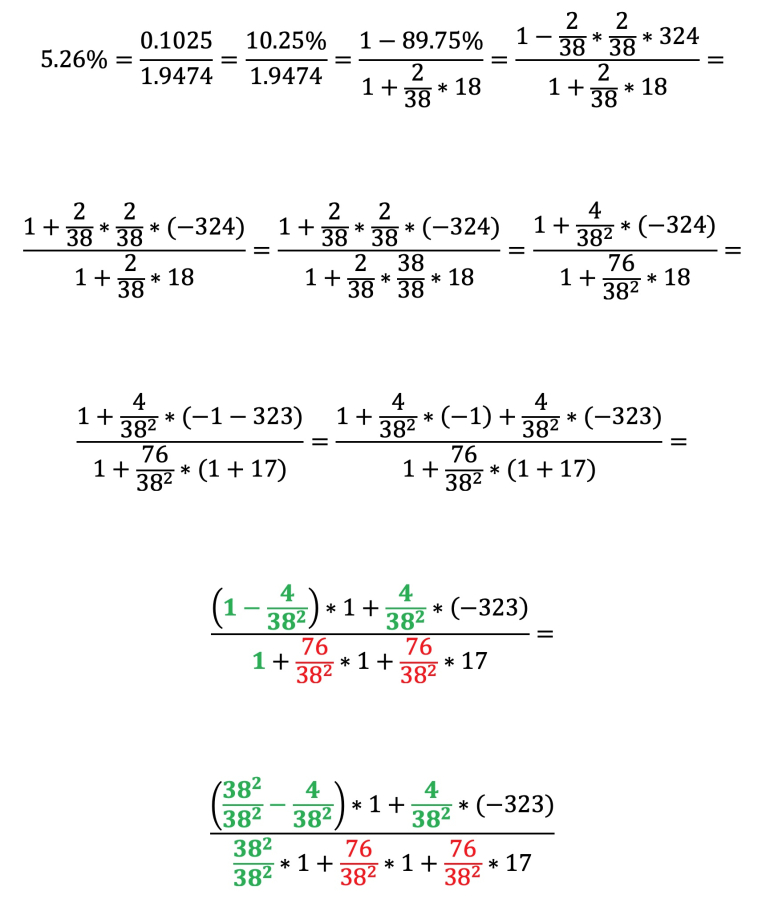November 29th, 2022 at 5:32:56 AM
permalink
Quote: WizardQuote: ThomasK
If the player wagered the parlay as proposed by the Wizard, how would the house edge now be 5.26%, while the house, offering the same bet, would nearly have twice the edge worth 10.25%?
If the player bet a pair of numbers in roulette with the intent to parlay everything if he won the first bet, then if he won the second bet he would have 18*18=324 times as much money as he started. In other words, his original bet would have been paid 323 to 1.
The expected return of such a strategy is (2/38)*(2/38)*324 = 89.75%. In other words, a house edge of 10.25%.
The question asks how is this possible if the individual bets have a house edge of 5.26%.
The answer is that the player is betting more than 1 unit under this strategy. He is actually betting, on average, 1+(2/38)*18 = 1.9474 units.
The ratio of the expected loss to the expected bet is 0.1025/1.9474 = 5.26%.
Please see here the proof that the player does not wager 18 units while trying to win 323 units to his initial 1 unit or losing the 1 unit otherwise.
NECESSARY TERMS CONFIRMED BY THE WIZARD
Units won on success
18*18=324
which pays
323 to 1
Return under this strategy
(2/38)*(2/38)*324 = 89.75%
House edge derived from this return
1 - 89.75% = 10.25%
HYPOTHESIS ABOUT THE WAGER AND THE CORRESPONDING HOUSE EDGE
Average wager under this strategy
1+(2/38)*18 = 1.9474
House edge derived from this wager
0.1025/1.9474 = 5.26%
PROOF: THE WAGER ONLY CONSISTS OF THE INITIAL 1 UNIT

Starting from the hypothesis of a house edge of 5.26%, based on the hypothetical wager of 1.9474 units, and expanding the terms step by step based on the confirmed and agreed terms it becomes visible:
1) The probabilities highlighted in green in the enumerator as well as in the denominator each add up to 1 and therefore represent all possible trials when parlaying for any two zeroes in a row. Supporting this, each highlighted green outcome in the enumerator matches each highlighted green wager in the denominator, i.e the player wagers on each trial.
2) When adding the probabilities highlighted in red, the total probability exceeds one, or 100%, which is not possible for random events. Therefore the excess amounts have to be rejected as being part of the wager. Not only are the 17 units of "intermediate winnigs" not a wager, as they can be replaced by the non-monetary "2G'$" puck. It also becomes visible that the player would wager more than 100% of initial 1 units for 100% of trials. Furthermore, no outcomes in the enumarator remain available for matching these excess units.
The general reason lies in the fact that the 18 units (=1+17), during the attempt to win 323 units on any two successive zeroes, are not independent but strictly depend on the previous wager, according to the rules of the parlay. Therefore they are not an independent wager themselves. Only the initial 1 unit is the independent wager for any attempt. The proof for not being independent is described in my earlier thread "When random variables are independent - and aren't".
As a consequence, the house edge for a player betting on any two successive zeroes is 10.25%, no matter whether the house offers this bet using the "2G'$" puck or whether the player is trying manually by parlaying.
REFERENCES
link to original post
"When random variables are independent - and aren't"
Last edited by: unnamed administrator on Nov 29, 2022
"When it comes to probability and statistics, intuition is a bad advisor. Don't speculate. Calculate." - a math textbook author (name not recalled)


